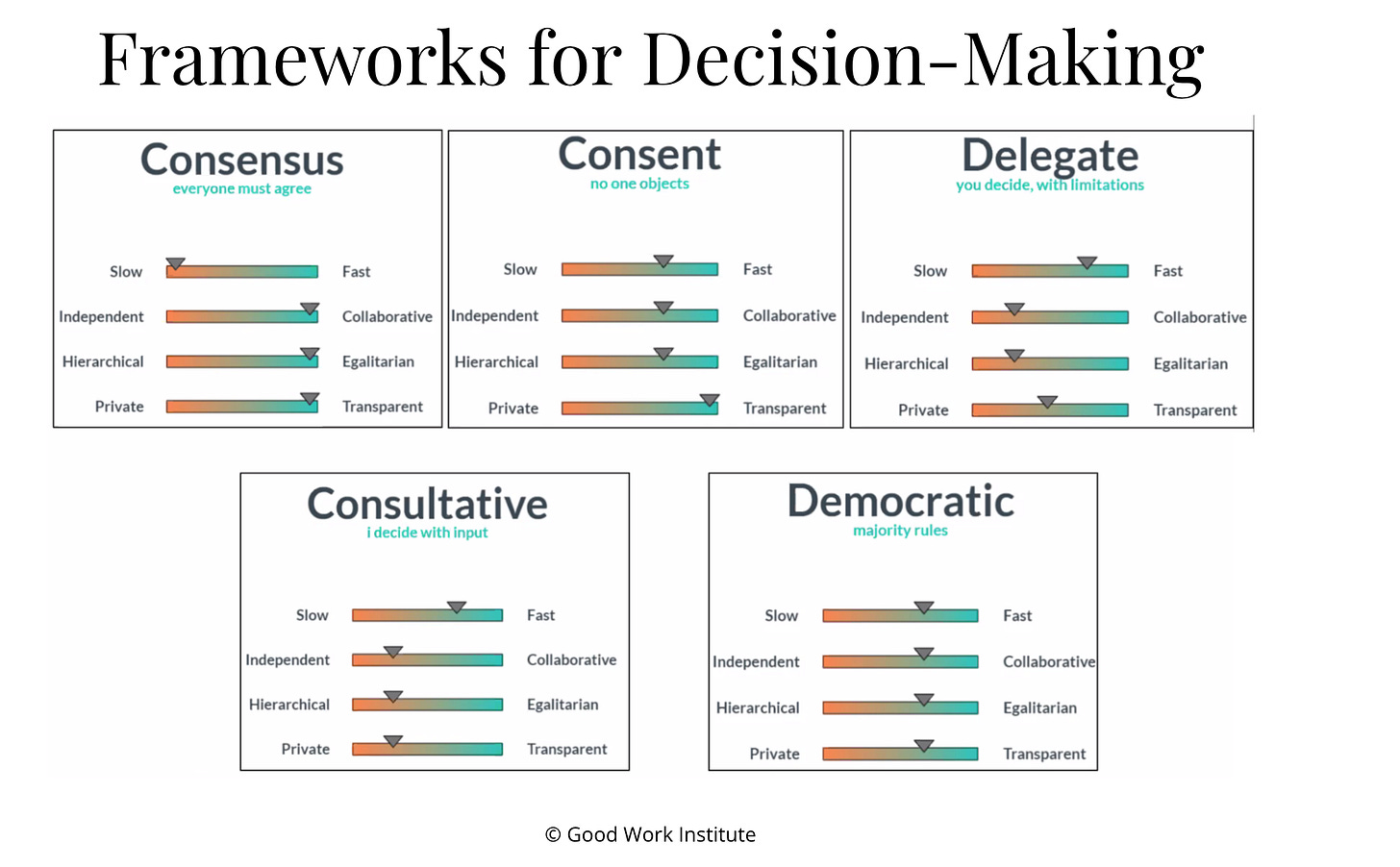“Decision-making is the heartbeat of life, pulsating through every moment. Each choice shapes our journey, guiding us toward our goals or diverting us from our path.”
This quote is a bit dramatic, but it does get the point across. Decisions determine our individual/company/societal outcomes. Also true: speed is the currency of startups.
How to reconcile diligence and speed?
Well, it depends. Below is a practice guide to making the right decisions, by modifying your approach to the decision at hand.
Quick start guide
Decide what you are deciding
You know that feeling when everyone in a meeting is looking around knowing that no-one knows what we are talking about anymore? Don’t be the guy leading that presentation. Say the decision out loud
Decide what approach is needed
I use different approaches for different kinds of decisions, based on how consequential and irreversible they are
Spend the most time on decisions that are both consequential, materially impact company outcomes, and irreversible, cannot easily be walked back
For these consequential and irreversible decisions, use a consultative decision making approach
Consultative decisions empowers decisions makers to own their final decision while gathering all the relevant information from subject matter experts
This helps focus your time on what matters. We make 35,000 decisions every day, but a tiny fraction of them are consequential enough to determine your outcomes
If less consequential or irreversible, decision maker should make faster decisions (eg. unilaterally or with one of the approaches below)1
Note: I will focus the rest of this article on consequential and irreversible decisions as they disproportionately drive outcomes
Assign roles and responsibilities
Use the RAPID2 framework
Recommend: Develops recommendation for decision, and owns 80% of the work
Agree: Ensures recommendation meets specific mandatory requirements (eg. legal/regulatory)
P: Executes decision once make
Input: Provides perspective that should be considered before making a decision. This usually comes from people who are the most knowledgeable about a given subject
Decide: Makes the decision. Takes inputs from others, evaluates inputs with their own ideas, and then makes the most informed decision possible
At minimum, you need a single (D)ecision maker (important it is a single person) and folks to provide (I)nput. That is enough for most decisions, although you may want to incorporate more roles with more complexity (eg. more consequential decision, more risk, etc.)
Drive the decision
Decisions don’t just get made in a vacuum. In order to drive real progress, it is important to bring along and get buy-in from stakeholders, which serves two purposes:
Sharpen your ideas and get to the best decision possible
We want the best ideas to win, and the best way to do that is put your thoughts in front of others
In short, create an idea meritocracy
Bring others along in the decision making process
Even if you think you already have the optimal decision, taking a few minutes to bring stakeholders along with your thinking will increase buy in and friction
When you inevitably hit a road block during execution, having buy-in early prevents the “I told you so” whispers from creeping in from stakeholders, and ultimately preventing progress
Lots of times people will disagree with your decision, but knowing that you considered their input allows them to “disagree and commit”
How?
Early low-fidelity alignment
Goal: Get stakeholders bought into high level direction
Early in the decision making process, align on the high level goals, decision, impact, scope, and approach
This will ensure key stakeholders are pushing in the right direction, and any misalignment is inexpensive (ie. caught before too much work is done)
High fidelity alignment meeting
Goal: Get stakeholders bought into the specifics of the decision
Later in the project, align on all the most important details
At this point, the decision maker should have thought through the options, highlighted the tradeoffs, and proposed the recommended path forward
Misconceptions
One misconception of gathering input/feedback is that you as the decision maker must take and incorporate all feedback
It can feel disempowering if approached like that
Consider re-framing as “I am sharpening my thoughts to make the optimal decision, whether that agrees or disagrees with the feedback” vs. “I am taking orders from X person”
Furthermore, it can be stifling to feel like you need to wait for input from everyone
Instead, take ownership of the decision
A great tool is the I intend to ..3 framework
Say what you are planning to do by when, unless there is blocking feedback from others before a certain deadline
Allows decision maker to ship quickly and own the decision, while still giving others a chance to provide feedback
Now step into the arena and make it happen. Godspeed.
Template
Inspired by Matt Mochary’s RAPID framework template4
Decision to be made
Goal(s)
[Optional] Other notes
Context
Impact
Scope
Roles
Recommend:
Agree:
Perform:
Input:
Decide:
Options
[Recommendation] Option 1
Pros:
Cons:
Option 2
Pros:
Cons:
Option 3
Pros:
Cons:
Feedback
Image from Good Work Institute




